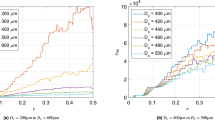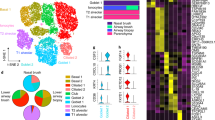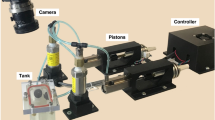Abstract
Asthma is a common disease affecting an increasing number of children throughout the world. In asthma, pulmonary airways narrow in response to contraction of surrounding smooth muscle. The precise nature of functional changes during an acute asthma attack is unclear. The tree structure of the pulmonary airways has been linked to complex behaviour in sudden airway narrowing1,2 and avalanche-like reopening3,4. Here we present experimental evidence that bronchoconstriction leads to patchiness in lung ventilation, as well as a computational model that provides interpretation of the experimental data. Using positron emission tomography, we observe that bronchoconstricted asthmatics develop regions of poorly ventilated lung. Using the computational model we show that, even for uniform smooth muscle activation of a symmetric bronchial tree, the presence of minimal heterogeneity breaks the symmetry and leads to large clusters of poorly ventilated lung units. These clusters are generated by interaction of short- and long-range feedback mechanisms, which lead to catastrophic shifts similar to those linked to self-organized patchiness in nature5,6. This work might have implications for the treatment of asthma, and might provide a model for studying diseases of other distributed organs.
This is a preview of subscription content, access via your institution
Access options
Subscribe to this journal
Receive 51 print issues and online access
$199.00 per year
only $3.90 per issue
Buy this article
- Purchase on Springer Link
- Instant access to full article PDF
Prices may be subject to local taxes which are calculated during checkout




Similar content being viewed by others
References
Suki, B. & Frey, U. Temporal dynamics of recurrent airway symptoms and cellular random walk. J. Appl. Physiol. 95, 2122–2127 (2003)
Mauroy, B., Filoche, M., Weibel, E. R. & Sapoval, B. An optimal bronchial tree may be dangerous. Nature 427, 633–636 (2004)
Suki, B., Barabasi, A. L., Hantos, Z., Petak, F. & Stanley, H. E. Avalanches and power-law behaviour in lung inflation. Nature 368, 615–618 (1994)
Alencar, A. M. et al. Physiology: Dynamic instabilities in the inflating lung. Nature 417, 809–811 (2002)
Judd, S. L. & Silber, M. Simple and superlattice Turing patterns in reaction-diffusion systems: bifurcation, bistability, and parameter collapse. Physica D. 136, 45–65 (2000)
Rietkerk, M., Dekker, S. C., de Ruiter, P. C. & van de Koppel, J. Self-organized patchiness and catastrophic shifts in ecosystems. Science 305, 1926–1929 (2004)
Beigelman-Aubry, C. et al. Mild intermittent asthma: CT assessment of bronchial cross-sectional area and lung attenuation at controlled lung volume. Radiology 223, 181–187 (2002)
Lutchen, K. R. et al. Airway constriction pattern is a central component of asthma severity: the role of deep inspirations. Am. J. Respir. Crit. Care Med. 164, 207–215 (2001)
Samee, S. et al. Imaging the lungs in asthmatic patients by using hyperpolarized helium-3 magnetic resonance: assessment of response to methacholine and exercise challenge. J. Allergy Clin. Immunol. 111, 1205–1211 (2003)
Klarreich, E. Take a deep breath. Nature 424, 873–874 (2003)
Vidal Melo, M. F. et al. Quantification of regional ventilation-perfusion ratios with PET. J. Nucl. Med. 44, 1982–1991 (2003)
Anafi, R. C., Beck, K. C. & Wilson, T. A. Impedance, gas mixing, and bimodal ventilation in constricted lungs. J. Appl. Physiol. 94, 1003–1011 (2003)
Anafi, R. C. & Wilson, T. A. Airway stability and heterogeneity in the constricted lung. J. Appl. Physiol. 91, 1185–1192 (2001)
Lauwerier, H. Fractals: Endlessly Repeated Geometric Figures 71–73 (Princeton Univ. Press, Princeton, 1991)
Venegas, J. G. & Galletti, G. G. Low-pass filtering, a new method of fractal analysis: application to PET images of pulmonary blood flow. J. Appl. Physiol. 88, 1365–1373 (2000)
Altemeier, W. A., McKinney, S. & Glenny, R. W. Fractal nature of regional ventilation distribution. J. Appl. Physiol. 88, 1551–1557 (2000)
Fredberg, J. J. Bronchospasm and its biophysical basis in airway smooth muscle. Respir. Res. 5, 2 (2004)
Latourelle, J., Fabry, B. & Fredberg, J. J. Dynamic equilibration of airway smooth muscle contraction during physiological loading. J. Appl. Physiol. 92, 771–779 (2002)
Skloot, G., Permutt, S. & Togias, A. Airway hyperresponsiveness in asthma: a problem of limited smooth muscle relaxation with inspiration. J. Clin. Invest. 96, 2393–2403 (1995)
Bates, J. H. Bronchoconstriction and broken symmetry. Comments Theor. Biol. 3, 397–415 (1995)
Wagers, S. Polarized helium: changing our view of asthma. J. Allergy Clin. Immunol. 111, 1201–1202 (2003)
Laurent, F., Latrabe, V., Raherison, C., Marthan, R. & Tunon-de-Lara, J. M. Functional significance of air trapping detected in moderate asthma. Eur. Radiol. 10, 1404–1410 (2000)
Newman, K. B., Lynch, D. A., Newman, L. S., Ellegood, D. & Newell, J. D. Jr Quantitative computed tomography detects air trapping due to asthma. Chest 106, 105–109 (1994)
Cox, P. G., Miller, J., Mitzner, W. & Leff, A. R. Radiofrequency ablation of airway smooth muscle for sustained treatment of asthma: preliminary investigations. Eur. Respir. J. 24, 659–663 (2004)
Danek, C. J. et al. Reduction in airway hyperresponsiveness to methacholine by the application of RF energy in dogs. J. Appl. Physiol. 97, 1946–1953 (2004)
Smith, D. et al. Intravenous epinephrine in life-threatening asthma. Ann. Emerg. Med. 41, 706–711 (2003)
Musch, G. et al. Topographical distribution of pulmonary perfusion and ventilation, assessed by PET in supine and prone humans. J. Appl. Physiol. 93, 1841–1851 (2002)
Weibel, E. R. Morphometry of the Human Lung 115–126 (Berlin, Springer, 1963)
Smith, J. C., Butler, J. P. & Hoppin, F. G. Jr Contribution of tree structures in the lung to lung elastic recoil. J. Appl. Physiol. 57, 1422–1429 (1984)
Gunst, S. J. & Stropp, J. Q. Pressure-volume and length-stress relationships in canine bronchi in vitro . J. Appl. Physiol. 64, 2522–2531 (1988)
Acknowledgements
We are grateful to T. A. Wilson, K. M. Miller, E. Lowenstein, B. Suki, J. P. Butler, M. Reitkerk and J. J. Fredberg for their suggestions and comments during the preparation of the manuscript. J. A. Correia and W. M. Bucelewicz are thanked for their help with technical aspects of the tracer preparation. This work was funded by an NIH HLBI grant.Authors' contributions J.G.V. and T.W. contributed equally to the theoretical aspects of this work. All authors contributed to experimental components of this work.
Author information
Authors and Affiliations
Corresponding author
Ethics declarations
Competing interests
The authors declare that they have no competing financial interests.
Supplementary information
Supplementary Methods S1
Details of PET imaging of Bronchoconstriction and the Model of Bronchoconstriction in an Airway Tree (PDF 134 kb)
Supplementary Video Legends S2
Legends to accompany the below Supplementary Videos. (PDF 46 kb)
Supplementary Video S3
Regional kinetics of the 13NN tracer in an asthmatic subject at baseline illustrates an almost complete removal of the tracer by the end of a washout period. (MPG 687 kb)
Supplementary Video S4
Regional kinetics of the 13NN tracer in an asthmatic subject during bronchoconstriction shows a substantially reduced washout from large contiguous 'ventilation defects'. (MPG 645 kb)
Supplementary Figure S5
Full set of PET images from an asthmatic subject during bronchoconstriction showing the residual tracer before and after deep inspiration. (PDF 317 kb)
Supplementary Video S6
Spatial distribution and histogram of terminal unit ventilation in the network model during a slow steady increase in smooth muscle relative activation from 0 to 1. (MPG 5997 kb)
Supplementary Figure S7
Complex dynamics of ventilation within the model during the simulation as a function of smooth muscle activation level. (PDF 611 kb)
Supplementary Figure S8
Fraction of clusters size and fraction of severely obstructed units as a function of tidal volume. (PDF 56 kb)
Supplementary Figure S9
Airway radius, normalized by the corresponding radius in relaxed conditions, versus generation number for each of the model's 12 generations. (PDF 334 kb)
Rights and permissions
About this article
Cite this article
Venegas, J., Winkler, T., Musch, G. et al. Self-organized patchiness in asthma as a prelude to catastrophic shifts. Nature 434, 777–782 (2005). https://doi.org/10.1038/nature03490
Received:
Accepted:
Published:
Issue Date:
DOI: https://doi.org/10.1038/nature03490
This article is cited by
-
Asymmetric lung increases particle filtration by deposition
Scientific Reports (2023)
-
Thermodynamic and dynamical predictions for bifurcations and non-equilibrium phase transitions
Communications Physics (2023)
-
Experimental investigation of true triaxial unloading rockburst precursors based on critical slowing-down theory
Bulletin of Engineering Geology and the Environment (2023)
-
Identifying the critical states and dynamic network biomarkers of cancers based on network entropy
Journal of Translational Medicine (2022)
-
Interpretable machine learning-derived nomogram model for early detection of diabetic retinopathy in type 2 diabetes mellitus: a widely targeted metabolomics study
Nutrition & Diabetes (2022)
Comments
By submitting a comment you agree to abide by our Terms and Community Guidelines. If you find something abusive or that does not comply with our terms or guidelines please flag it as inappropriate.



